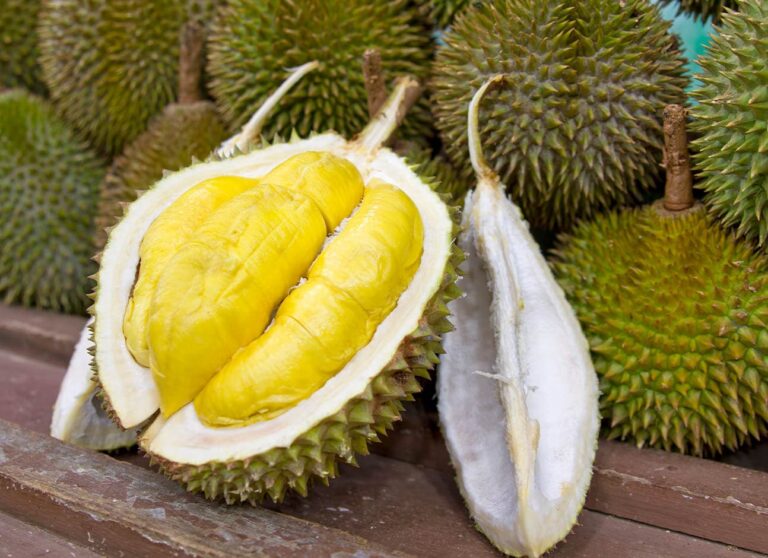Few fruits are as fascinating as Durian for food enthusiasts who love exploring the exotic and unusual. Often called the “king of fruits,” Durian is known for its creamy texture, rich taste, and—most famously—its polarizing smell. But what makes Durian unique, and why do opinions vary so much? Let’s dig in and explore everything you need to know about this intriguing tropical fruit, from its flavour profile to its cultural significance.
Table of Contents
Why is Durian Banned in Certain Places?
Durian is a fruit, but its overpowering odour has earned it a reputation like no other. Banned in public places across countries like the United States and the United Kingdom, Durian’s smell is a force to reckon with. Anthony Bourdain famously described it as “like you’d buried somebody holding a big wheel of Stilton cheese, then dug him up weeks later.”
A chemical compound causes the pungent aroma of ethionine, which increases as the fruit ripens. While some find the smell unbearable, durian fans often liken it to “heavenly.” Whether in an airport in Singapore (where Durian is banned from public transport) or attending an upscale dinner party, be cautious about bringing a durian—it’s considered both legend and liability.
What Does Durian Taste Like?
For those who can get past its smell, Durian offers a luxurious eating experience. Imagine a mix of creamy custard, sweet onion, and roasted garlic—yes, that’s right. It’s an unusual flavour combination that can be oddly satisfying.
The taste of Durian can vary depending on its ripeness. A perfectly ripe durian can have hints of almond and caramel, while an overripe one leans more toward savoury flavours, resembling a strong cheese. It’s a true adventure for the taste buds but not for the faint of heart.
Is Durian a Filipino Fruit?
Durian may be prevalent in the Philippines, but its origins lie across Southeast Asia. Cultivated in Indonesia, Malaysia, southern Thailand, and the Philippines, Durian is a regional delicacy with deep cultural ties. Whether included in dessert recipes or served straight from the husk, Durian seamlessly integrates into the culinary traditions of these regions.
However, due to its strong odour, the fruit is rare in international markets and often avoided by casual consumers outside Southeast Asia. For true durian lovers, its divisive nature is part of its charm.
Why Does Durian Smell the Way It Does?
That infamous stench? Blame ethionine! Studies reveal this sulfur-heavy amino acid is released in abundance as the fruit ripens. The smell is an evolutionary design to attract animals like monkeys and elephants, who eat the fruit and disperse its large seeds.
Interestingly, while some people describe Durian’s odour as akin to “gas leaks” or “raw sewage,” others find it floral or sweet. Love it or hate it, Durian is undoubtedly one of nature’s most aromatic creations.
Why Do Many Americans Hate Durian?
Taste and smell perception differ worldwide, and culture plays a significant role. Southeast Asians who grow up around Durian often associate its scent with nostalgia and home-cooked meals. On the other hand, Americans unfamiliar with the fruit may only focus on its pungent smell, which overshadows its taste.
Durian’s divisive reputation in the West boils down to familiarity. For most Americans, the fruit’s aroma and texture challenge their conventions of what fruit should be. This gap in cultural exposure makes Durian an acquired taste for many.
Is Durian Really That Nasty?
While some label durian “nasty,” there’s science behind its odour. The pungent smell serves a biological purpose—attracting animals that spread its seeds. Nature decided to use scent, not beauty, as Durian’s main selling point to the animal kingdom. Love it or leave it, the fruit is unapologetically unique.
Why is Durian so expensive?
Durian’s price tag often reflects its exclusivity. Some of the most prized durians, such as those grown in Nonthaburi, Thailand, owe their price to specific soil conditions, meticulous cultivation, and distinct flavour profiles. Durian enthusiasts are willing to pay a premium for these top-tier varieties, making the fruit more than a simple treat—it’s a luxury item.
Are Durian and Jackfruit the Same?
Although Durian and Jackfruit may look similar, they’re entirely different fruits. Jackfruit has a dense, fibrous texture and a flavour reminiscent of bananas and mangoes. Meanwhile, Durian boasts a creamy texture and a rich, multi-layered taste, including cheese, caramel, and garlic notes. Consider Jackfruit the approachable cousin, while Durian is the bold, eccentric elder sibling.
Does Durian Smell Like Gas?
Yes, it can. Some have compared its scent to gas leaks, raw sewage, or rotting garbage. Case in point? A recent gas leak scare in Munich was traced to none other than a forgotten durian. Its aroma is not for the faint-hearted.
What Animals Eat Durian?
Durian plays a vital role in Southeast Asia’s ecosystem. Elephants, orangutans, monkeys, and fruit doves feast on Durian. Thanks to its large seeds, these animals help disperse durian seeds far and wide, ensuring the fruit’s survival and reproduction.
What Foods Should You Avoid After Eating Durian?
Durian pairs well with sticky rice and coconut milk, but certain food combinations should be avoided for safety reasons. Mixing Durian with alcohol, coffee, spicy foods, or certain meats can lead to adverse reactions, including indigestion. Enjoy it, but do so mindfully!
Why Should You Try Durian?
Durian is more than just a fruit—it’s an experience. From its spiky husk to its unforgettable taste, Durian challenges your culinary comfort zone and offers a rare glimpse into Southeast Asian culture. Nutritionally, it’s a powerhouse rich in fibre, vitamins, and antioxidants, making it a surprisingly healthy option when eaten in moderation.
For a true foodie, Durian represents a badge of courage and curiosity. Can you handle the “king of fruits”?


